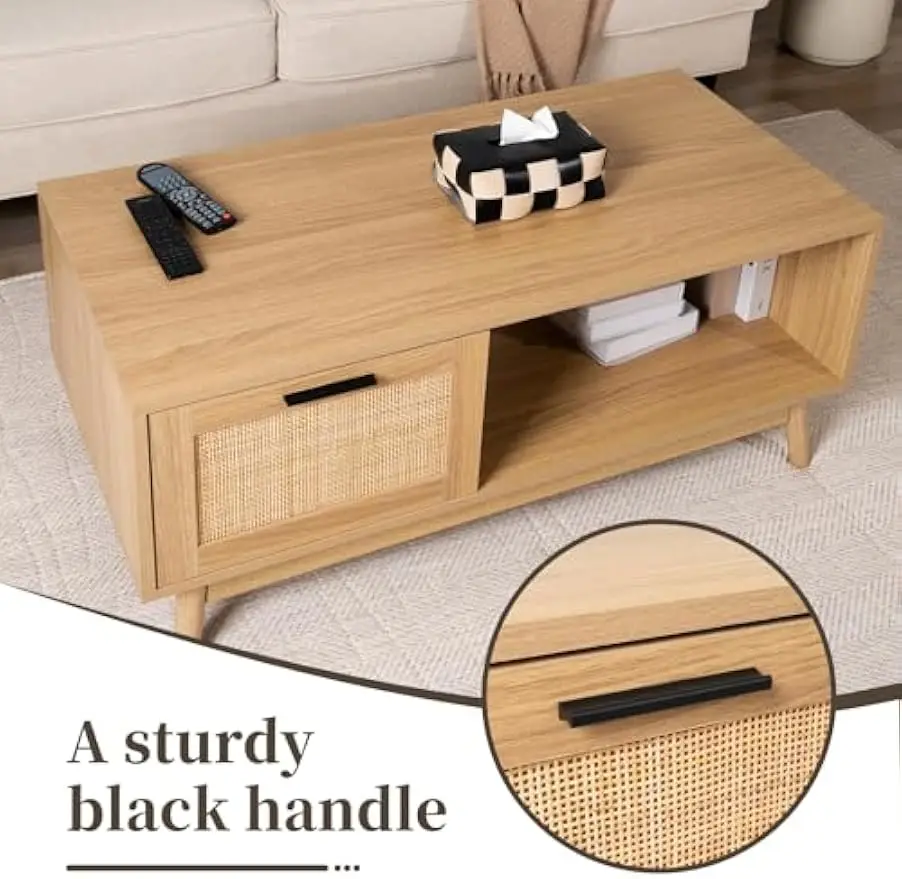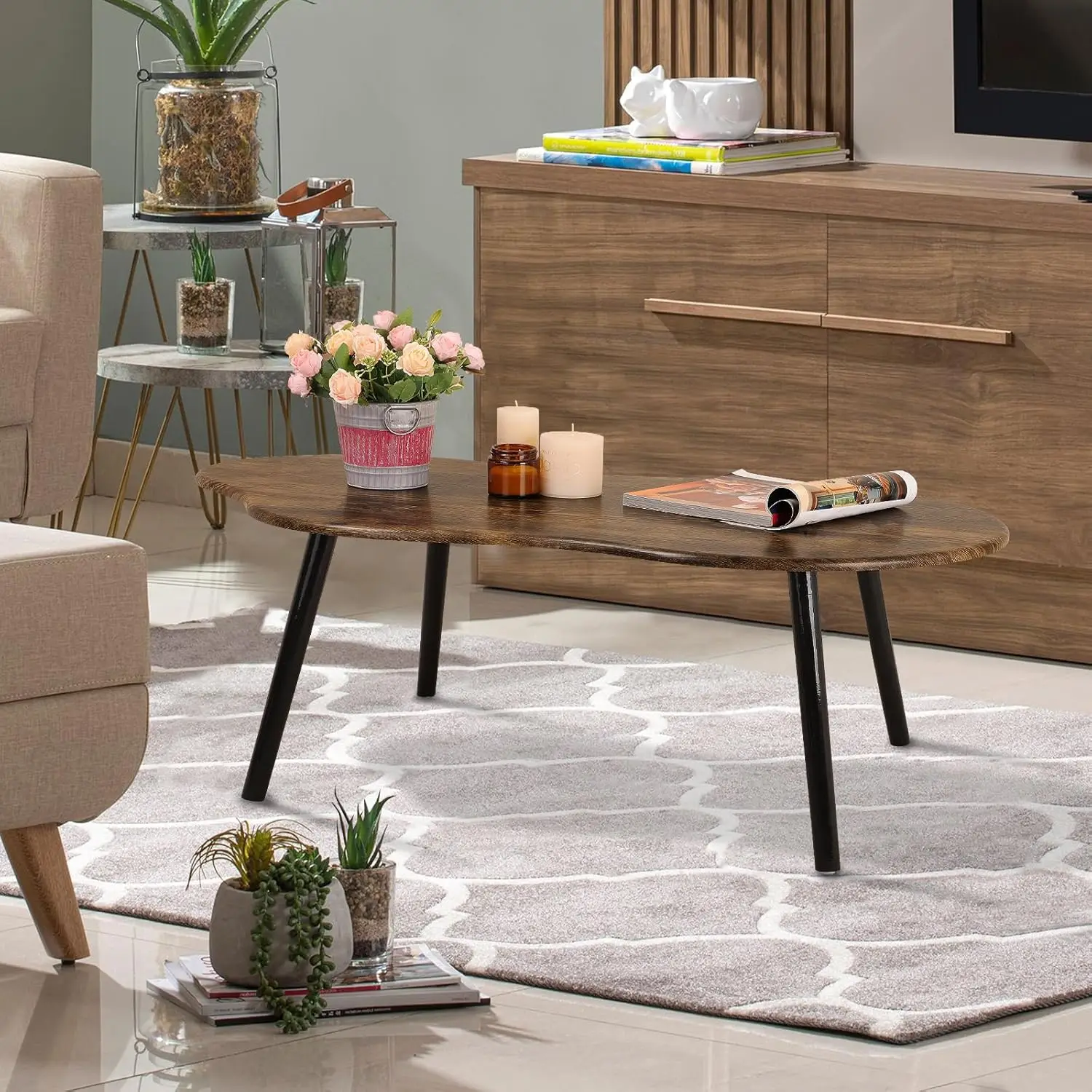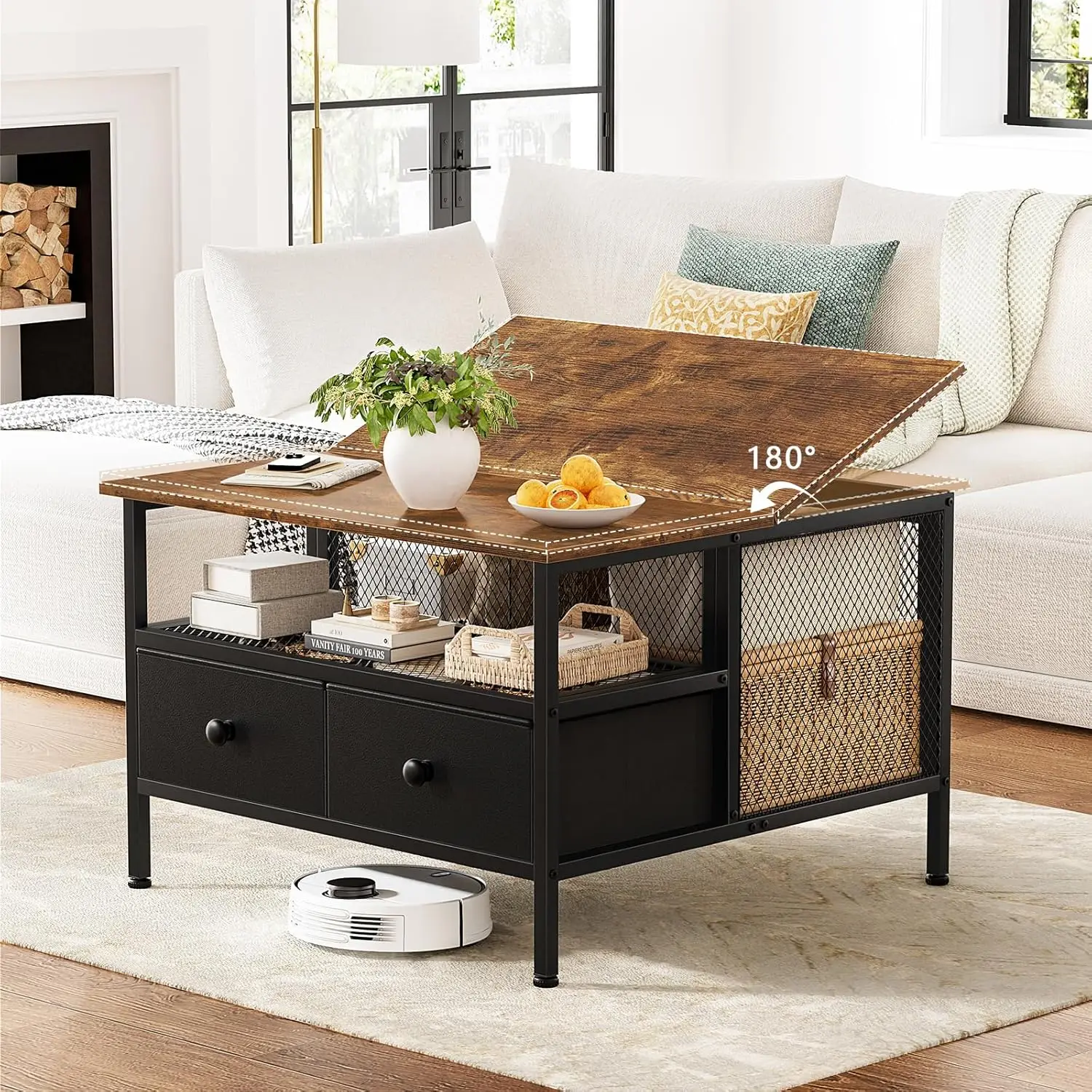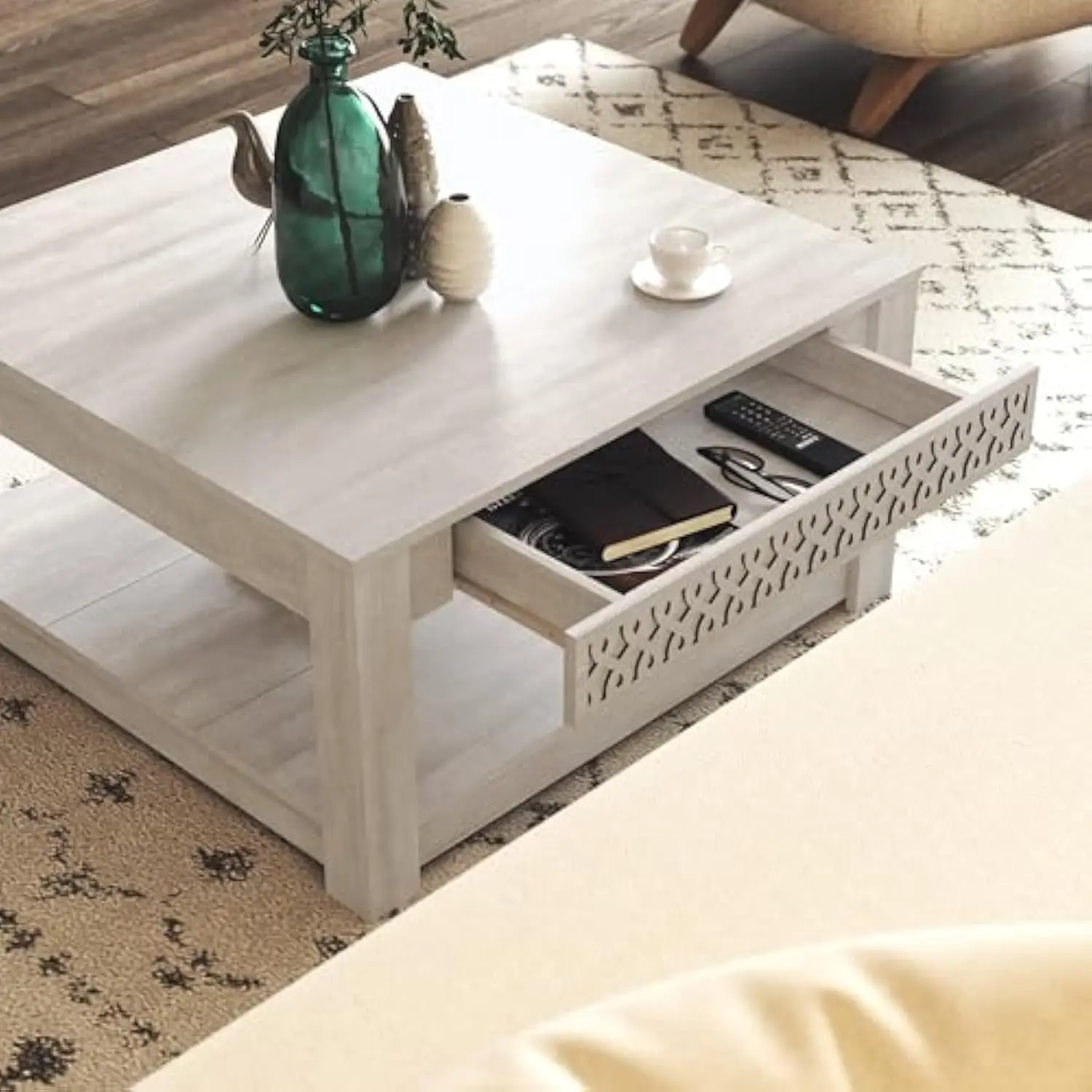Understanding Solid Wood: The Foundation of Quality and Durability
When furnishing your living space, few pieces make as significant an impact as a coffee table. At the heart of many quality coffee tables lies solid wood—a material celebrated for its authenticity, character, and lasting value. Unlike engineered alternatives, solid wood coffee tables are crafted from continuous pieces of natural timber, offering unmatched durability and aesthetic appeal.
What sets solid wood apart from engineered options like particleboard, MDF (Medium-Density Fiberboard), or veneered furniture is its complete composition of natural wood throughout. These mid-century modern solid wood coffee tables exemplify how natural materials create foundations for both beauty and longevity in home furnishings.
Solid wood offers several distinct advantages:
- Exceptional durability that withstands decades of daily use
- Ability to be refinished multiple times, extending its lifespan
- Development of a rich patina that enhances character over time
- Superior structural integrity without compromising on aesthetics
You can easily identify genuine solid wood by examining a few key characteristics. Look for consistent grain patterns that flow naturally across surfaces, substantial weight compared to similar-sized engineered pieces, and visible end grain on edges. Unlike veneer furniture that shows a thin layer of premium wood over cheaper materials, solid wood maintains its quality throughout.
Many furniture enthusiasts consider solid wood coffee tables investment pieces rather than disposable furniture. While the initial cost may be higher, these pieces often become family heirlooms that appreciate in character and sometimes in monetary value over generations. The intelligent black mid-century coffee tables demonstrate how thoughtfully chosen wood furniture becomes both functional art and a lasting investment.
Wood Species: Selecting the Perfect Character and Durability
The species of wood you select for your coffee table significantly impacts its appearance, durability, and maintenance requirements. Each wood type brings unique characteristics to your living space, from distinctive grain patterns to natural color variations that evolve beautifully over time.
Hardwoods: Premium Choices for Lasting Quality
Hardwoods represent the gold standard for quality furniture, offering superior durability and timeless appeal. These woods come from deciduous trees that typically grow more slowly, resulting in denser, more resilient timber ideal for high-use furniture pieces.
Popular hardwood options include:
- Walnut: Prized for its rich, chocolate-brown tones and straight grain that occasionally features stunning figuring. Mid-century modern walnut coffee tables showcase this wood’s ability to create sophisticated, warm centerpieces.
- Oak: Known for pronounced grain patterns and exceptional durability. Red oak offers warmer tones while white oak features greyer, cooler undertones.
- Maple: Appreciated for its light color and subtle grain, maple presents a clean, contemporary look that brightens spaces.
- Cherry: Begins with a lighter pinkish hue that deepens to a rich reddish-brown with age and light exposure, offering a living quality that changes over time.
The hardness of these woods is often measured using the Janka scale, which indicates resistance to denting and wear. Higher numbers represent harder, more durable woods:
| Wood Type | Janka Hardness Rating | Relative Durability |
|---|---|---|
| Walnut | 1,010 | Medium-High |
| Cherry | 950 | Medium |
| White Oak | 1,360 | High |
| Hard Maple | 1,450 | Very High |
Hardwoods typically command higher prices, reflecting both their quality and longevity. However, their ability to remain beautiful for generations often justifies the investment.
Softwoods: Accessible Options with Rustic Charm
Softwoods, derived from coniferous trees, offer more affordable solid wood options with distinctive rustic appeal. While generally less dense than hardwoods, quality softwood coffee tables can still provide decades of service when properly constructed and maintained.
Common softwood options include:
- Pine: Light in color with noticeable knots that add character
- Fir: Straight-grained with a reddish-brown tone that ages beautifully
Pros of softwood coffee tables:
– More budget-friendly entry point to solid wood furniture
– Rustic aesthetic that works well in country, farmhouse, and casual decors
– Lighter weight makes rearranging easier
Cons to consider:
– More susceptible to dents and scratches
– Typically require more diligent maintenance
– May show wear more quickly than hardwood alternatives
Softwoods generally benefit from more protective finishes to enhance their durability in high-traffic settings.
Reclaimed Wood: Character with Environmental Benefits
Reclaimed wood coffee tables offer unique character impossible to replicate in new lumber. Sourced from old barns, factories, and other structures, these timbers bring history and distinctive weathering to your living space.
Beyond their unique aesthetic appeal, reclaimed wood offers environmental benefits by reusing existing materials. The aged timber is often more stable and, surprisingly, sometimes stronger than newly harvested wood due to its slow, natural aging process.
The ultimate guide to solid wood coffee tables explores these wood types in greater depth, helping you understand which might best suit your specific needs and preferences.
Construction Quality: Ensuring Longevity and Stability
Even the finest wood species can’t compensate for poor construction. How a coffee table is built determines whether it will remain sturdy and beautiful for decades or begin to loosen and fail within years.
Quality joinery represents the most telling indicator of construction excellence. Premium solid wood coffee tables feature traditional woodworking techniques that allow the pieces to expand and contract with seasonal humidity changes while maintaining structural integrity. Look for these hallmarks of quality construction:
- Dovetail joints in drawers, recognized by their interlocking “tails” and “pins” that create nearly unbreakable connections
- Mortise and tenon joints where one piece fits precisely into a cavity in another, creating strong connections at leg and apron junctions
- Finger or box joints that interlock pieces with mechanical strength beyond what glue alone provides
Conversely, mass-produced tables often exhibit shortcuts that compromise durability:
– Excessive visible glue squeezing from joints
– Staples or visible screws holding structural components
– Corner blocks used to reinforce otherwise weak joints
– Gaps in joinery indicating poor craftsmanship
Proper construction also accommodates wood’s natural tendency to expand and contract with humidity changes. Quality pieces incorporate design elements like floating panels or breadboard ends that allow movement without causing warping or splitting. The features of black mid-century coffee tables demonstrate how thoughtful construction enhances both durability and visual appeal.

Finishes and Surface Treatments: Protection and Aesthetics
The finish applied to your solid wood coffee table serves dual purposes: enhancing the natural beauty of the wood grain while providing crucial protection against daily wear, moisture, and staining. Different finish types offer varying levels of protection and aesthetic results.
Common finish types include:
Oil finishes (like tung or linseed oil): These penetrate the wood, enhancing grain depth and providing a natural, matte look with a tactile quality that lets you feel the wood grain. While easily repairable, they offer less protection against moisture and require more frequent maintenance.
Lacquer and varnish finishes: These create protective films on the wood surface that provide excellent resistance against moisture and wear. They range from high-gloss to satin sheens and offer stronger protection than oils, though repairs can be more complicated.
Polyurethane finishes: Offering the highest level of protection, these durable synthetic finishes resist scratching, water damage, and heat. Water-based versions provide excellent clarity while oil-based types add amber warmth to the wood.
When selecting a finish, consider your household’s specific needs. Homes with young children or pets might benefit from more durable polyurethane finishes, while design-focused spaces without heavy use might showcase the natural beauty of oil finishes. The black mid-century coffee table design considerations include how different finishes impact both protection and visual appeal.
Regardless of finish type, quality applications should enhance rather than obscure the natural beauty of the wood. The finish should feel smooth without drips, bubbles, or inconsistencies that indicate rushed production.
Design and Style: Finding Harmony with Your Space
Coffee tables do more than provide functional surfaces—they establish visual anchors in your living space and reflect your personal style. Understanding different design aesthetics helps you select a piece that complements your existing décor while making a cohesive statement.
Major coffee table style categories include:
Modern/Contemporary: Features clean lines, minimal ornamentation, and often incorporates mixed materials like wood with metal or glass. These pieces typically emphasize function and simplicity with geometric forms.
Rustic/Farmhouse: Celebrates natural wood characteristics including knots, irregular grain, and sometimes distressed finishes. These tables often feature chunkier proportions and showcase wood’s organic qualities.
Traditional: Incorporates classic design elements like turned legs, carved details, and more formal proportions. Often crafted from darker woods with richer finishes that convey timeless elegance.
Mid-Century Modern: Distinguished by organic curves balanced with geometric forms, tapered legs, and clean profiles. Our mid-century modern coffee tables collection showcases this enduring design aesthetic that bridges vintage charm with contemporary sensibilities.
When selecting a style, consider existing furniture pieces in your space. While perfect matching isn’t necessary, complementary design languages create cohesive interiors. Pay attention to key design elements like:
- Leg style (straight, splayed, turned, or pedestal)
- Edge treatment (square, rounded, beveled, or live edge)
- Surface texture (smooth, distressed, or carved)
- Hardware (minimal, decorative, or absent)

Size, Shape and Proportion: Finding the Perfect Fit
The dimensions and shape of your coffee table significantly impact both its functionality and visual balance within your space. Proper sizing ensures comfortable use while maintaining appropriate traffic flow around the piece.
As a general guideline, coffee table height should be within 1-2 inches of your sofa’s seat height—typically between 16-18 inches tall. This ensures comfortable use without awkward reaching up or down.
For length, aim for a table that’s about two-thirds the length of your sofa for balanced proportion. This provides adequate surface area while maintaining visual harmony. Clearance around the table is equally important—allow at least 18 inches between the table edge and seating for comfortable leg room, and ensure walkways around the table maintain at least 30 inches of clearance.
Different shapes offer distinct advantages:
- Rectangular tables provide maximum surface area and work well with standard sofas
- Round coffee tables eliminate sharp corners (ideal for homes with children) and create better flow in tight spaces
- Square tables complement sectional arrangements or create symmetry in larger rooms
- Organic or unusual shapes make artistic statements and can bring unique character to otherwise conventional spaces
Consider your room’s existing lines when selecting shapes—round tables soften spaces with many angular elements, while rectangular pieces can bring structure to rooms with many curved features.
Functional Features: Storage and Versatility
Beyond basic surface functionality, many solid wood coffee tables incorporate features that enhance their utility and adaptability to your specific lifestyle needs.
Storage options dramatically increase a coffee table’s functionality:
- Drawers provide concealed storage for remote controls, gaming controllers, and other small items
- Open shelves offer display space for books and decorative objects while maintaining accessibility
- Hidden compartments keep clutter completely out of sight
- Lift-top mechanisms create adjustable height surfaces for dining or working from the sofa
Lift-top coffee tables have gained popularity for their versatility, transforming from standard coffee tables to comfortable work surfaces or casual dining tables with simple mechanisms.
Other functional features worth considering include:
- Nesting tables that provide expandable surface area when needed
- Rounded corners for child safety in family homes
- Casters or wheels for easy repositioning
- Integrated features like built-in outlets or charging stations

Mid-Century Modern Solid Wood Coffee Tables, Mid-Century Modern Teak Coffee Tables
$879.95 Select options This product has multiple variants. The options may be chosen on the product pageMid-Century Modern Danish Coffee Tables, Mid-Century Modern Oval Coffee Tables, Mid-Century Modern Solid Wood Coffee Tables
$390.05 Select options This product has multiple variants. The options may be chosen on the product pageMid-Century Modern Coffee & End Table Sets, Mid-Century Modern Coffee Table Sets, Mid-Century Modern Oval Coffee Tables
Price range: $257.48 through $331.04 Select options This product has multiple variants. The options may be chosen on the product pageMid-Century Modern Glass Top Coffee Tables, Mid-Century Modern Glass Top Side & End Tables
$460.58 Select options This product has multiple variants. The options may be chosen on the product pageMid-Century Modern Glass Top Coffee Tables, Mid-Century Modern Vintage Coffee Tables, Mid-Century Modern Vintage Side & End Tables
$725.36 Select options This product has multiple variants. The options may be chosen on the product pageMid-Century Modern Lift Top Coffee Tables, Mid-Century Modern Square Coffee Tables
$454.73 Select options This product has multiple variants. The options may be chosen on the product page
When evaluating functional features, consider your daily activities. Do you frequently work from your living room? A lift-top might be invaluable. Do you entertain often? Additional surface area from nesting tables could prove essential. The best functional features are those that solve your specific lifestyle challenges.
Care and Maintenance: Protecting Your Investment
Proper maintenance ensures your solid wood coffee table remains beautiful for generations. While solid wood is remarkably durable, it does require some care to maintain its appearance and structural integrity.
Essential care guidelines include:
- Use coasters under beverages to prevent water rings and heat damage
- Clean with a soft, slightly damp cloth rather than chemical cleaners
- Dust regularly with a microfiber cloth to prevent buildup that can scratch surfaces
- Apply appropriate wood conditioners or polish recommended for your specific finish type
Preventative measures make a substantial difference in longevity:
– Use felt pads under decorative objects that remain on the table
– Position the table away from direct sunlight to prevent uneven fading
– Maintain consistent indoor humidity (30-50%) to prevent excessive wood movement
– Address spills immediately to prevent staining or finish damage
Seasonal care may include re-applying appropriate conditioners to nourish the wood and maintain its luster. For tables with oil finishes, plan to refresh the oil 1-2 times annually to maintain protection.
Should damage occur, many solid wood pieces can be professionally restored—another advantage over engineered furniture that typically can’t be refinished. The styling of black mid-century coffee tables provides additional insights into maintaining these pieces while maximizing their visual impact.
Sustainability and Ethical Considerations
As environmental awareness grows, many consumers prioritize furniture that aligns with sustainable and ethical practices. Solid wood coffee tables can be environmentally responsible choices—particularly when sourced thoughtfully.
Look for these certifications that indicate responsible sourcing:
- Forest Stewardship Council (FSC) certification ensures wood comes from responsibly managed forests
- Sustainable Forestry Initiative (SFI) indicates adherence to sustainable forestry practices
- GREENGUARD certification guarantees low chemical emissions from finishes
Different wood species carry different environmental impacts. Domestic hardwoods often have smaller carbon footprints than exotic species that require extensive shipping. Fast-growing species like maple regenerate more quickly than slower-growing varieties like walnut.
Reclaimed wood represents perhaps the most environmentally friendly option, repurposing existing timber rather than harvesting new trees. Beyond reducing logging demand, reclaimed wood diverts materials from landfills and often requires less energy-intensive processing.
Finishes also impact environmental considerations. Low-VOC (Volatile Organic Compound) finishes reduce harmful emissions during manufacturing and in your home, contributing to better indoor air quality and reduced environmental impact.
Budget Considerations: Value Beyond the Price Tag
Solid wood coffee tables span a wide price spectrum, typically ranging from a few hundred dollars for simpler softwood designs to several thousand for premium hardwood pieces with exceptional craftsmanship. Understanding what drives these price differences helps you make informed investment decisions.
Key factors influencing price include:
- Wood species (rare or exotic woods command premium prices)
- Construction quality (traditional joinery increases labor costs but ensures longevity)
- Design complexity (intricate details, carved elements, or complex shapes require more skilled labor)
- Brand reputation (established artisanal makers often command higher prices)
When establishing your budget, consider long-term value rather than just initial cost. A well-crafted solid wood coffee table might cost more initially but could serve your home for decades—or even generations—while cheaper alternatives might need replacement within years.
If working with budget constraints, consider these strategic approaches:
– Prioritize construction quality over premium wood species
– Consider domestic rather than exotic hardwoods
– Look for simpler designs that require less labor-intensive craftsmanship
– Explore softwoods like pine that offer solid wood benefits at lower price points
The styles that go well with mid-century modern approach demonstrate how thoughtful selection can maximize both aesthetic impact and value regardless of budget constraints.
Is a Solid Wood Coffee Table Right for Your Home?
While solid wood coffee tables offer numerous advantages, they’re not universally the best choice for every home or lifestyle. Consider these questions to determine if solid wood aligns with your specific needs:
- Do you value long-term investment pieces over trendy, replaceable furniture?
- Are you comfortable with natural variations and character development in wood?
- Does your lifestyle accommodate some basic maintenance requirements?
- Do you appreciate the warmth and organic quality natural materials bring to spaces?
Solid wood particularly shines compared to alternatives in several scenarios:
– Homes seeking timeless design that transcends trends
– Spaces where authenticity and natural materials are design priorities
– Households willing to invest upfront for longer-term value
– Environments where quality and craftsmanship are valued
For comparison, glass vs. wood coffee tables presents different aesthetic and practical considerations. Glass offers sleek, contemporary styling and visually lighter presence but lacks wood’s warmth and repairability. Metal provides industrial appeal and exceptional durability but often feels colder both visually and tactilely.
The enduring appeal of solid wood lies in its perfect balance of beauty, functionality, and longevity. When thoughtfully selected, a solid wood coffee table becomes not just furniture, but a centerpiece that anchors your living space while telling a story that evolves beautifully over time.







